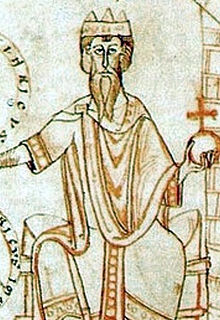
Back كونراد الثاني Arabic كونراد التانى ARZ ایکینجی کنراد (آلمان) AZB Конрад II (імператар Свяшчэннай Рымскай імперыі) Byelorussian Конрад II Bulgarian Konrad II, car Svetog Rimskog Carstva BS Conrad II del Sacre Imperi Romanogermànic Catalan Konrád II. Sálský Czech Conrad II, Ymerawdwr Glân Rhufeinig Welsh Konrad 2. (Tysk-romerske rige) Danish
| Conrad II | |
|---|---|
| Emperor of the Romans | |
 Miniature depiction, c. 1130 | |
| Holy Roman Emperor | |
| Reign | 26 March 1027 – 4 June 1039 |
| Coronation | 26 March 1027 Old St. Peter's Basilica, Rome |
| Predecessor | Henry II |
| Successor | Henry III |
| King of Burgundy | |
| Reign | 6 September 1032 – 4 June 1039 |
| Predecessor | Rudolph III |
| Successor | Henry III |
| King of Italy | |
| Reign | 25 March 1026 – 4 June 1039 |
| Coronation | 25 March 1026[1] Basilica of Sant'Ambrogio, Milan |
| Predecessor | Henry II |
| Successor | Henry III |
| King of Germany | |
| Reign | 8 September 1024 – 4 June 1039 |
| Coronation | 8 September 1024 Mainz Cathedral, Mainz |
| Predecessor | Henry II |
| Successor | Henry III |
| Born | c. 989/990 Speyer, Duchy of Franconia, Kingdom of Germany, Holy Roman Empire |
| Died | 4 June 1039 (aged 48 or 49) Utrecht, Lower Lorraine, Kingdom of Germany, Holy Roman Empire |
| Burial | |
| Spouse | |
| Issue | Henry III, Holy Roman Emperor Matilda of Franconia |
| House | Salian |
| Father | Henry, Count of Speyer |
| Mother | Adelaide of Metz |
Conrad II (German: Konrad II, c. 989/990 – 4 June 1039), also known as Conrad the Elder and Conrad the Salic, was the emperor of the Holy Roman Empire from 1027 until his death in 1039. The first of a succession of four Salian emperors, who reigned for one century until 1125, Conrad ruled the kingdoms of Germany (from 1024), Italy (from 1026) and Burgundy (from 1033).
The son of Franconian count Henry of Speyer (also Henry of Worms) and Adelaide of Metz of the Matfriding dynasty, that had ruled the Duchy of Lorraine from 959 until 972, Conrad inherited the titles of count of Speyer and Worms during childhood after his father had died around the year 990. He extended his influence beyond his inherited lands, as he came into favour of the princes of the kingdom. When the imperial dynastic line was left without a successor after Emperor Henry II's death in 1024, on 4 September an assembly of the imperial princes appointed the 34-year-old Conrad king (Rex romanorum).[2][3]
Conrad II adopted many aspects of his Ottonian predecessor Henry II regarding the role and organisation of the Church as well as general rulership practices, which in turn had been associated with Charlemagne.[4] While the emperor was not anti-monastic, he immediately abandoned the favouritism that had been shown to men of the Church under Henry II.[5] In Italy, he initially relied on the bishops (mostly of German origin) to maintain imperial power. Beginning with his second Italian expedition in 1036, he changed his strategy and managed to win the support of the valvassores (lesser nobles) and the military elite, who challenged the power of the bishops.[6][7][8] His reign marked a high point of medieval imperial rule during a relatively peaceful period for the empire. Upon the death of the childless King Rudolph III of Burgundy in 1032, Conrad claimed dominion over the Kingdom of Burgundy, conquered it with German and Italian troops, and incorporated it into the empire.[3][7] The three kingdoms (Germany, Italy and Burgundy) formed the basis of the empire as the "royal triad" (regna tria).
- ^ Wolfram 2010, p. 97.
- ^ Wolfram 2006, p. 18.
- ^ a b Weinfurter 1999, p. 49.
- ^ Weinfurter 1999, pp. 26.
- ^ Wolfram 2010, p. 322.
- ^ Weinfurter 1999, pp. 45–47.
- ^ a b Cite error: The named reference
boniwas invoked but never defined (see the help page). - ^ Blumenthal, Uta-Renate (1988). The Investiture Controversy: Church and Monarchy from the Ninth to the Twelfth Century. University of Pennsylvania Press. pp. 45–. ISBN 0-8122-1386-6.